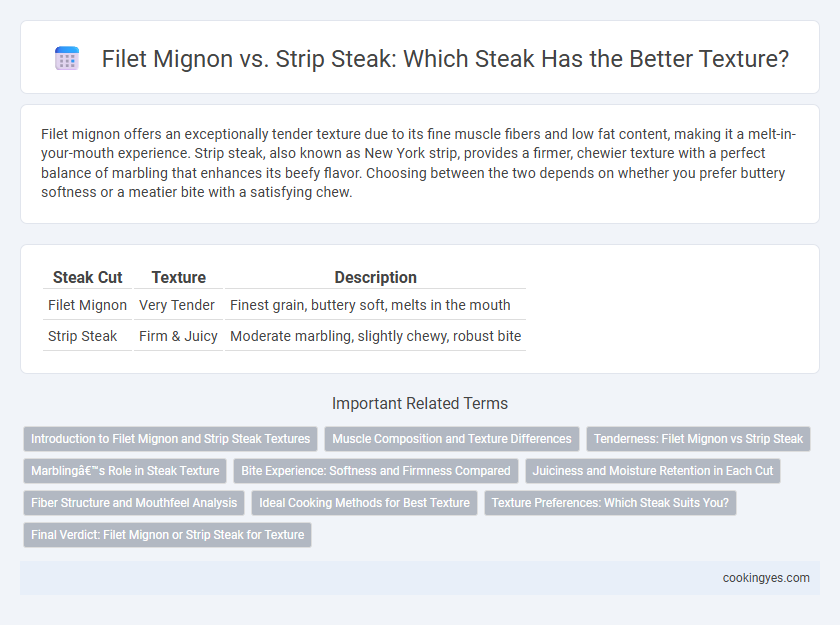Filet mignon offers an exceptionally tender texture due to its fine muscle fibers and low fat content, making it a melt-in-your-mouth experience. Strip steak, also known as New York strip, provides a firmer, chewier texture with a perfect balance of marbling that enhances its beefy flavor. Choosing between the two depends on whether you prefer buttery softness or a meatier bite with a satisfying chew.
Table of Comparison
| Steak Cut | Texture | Description |
|---|---|---|
| Filet Mignon | Very Tender | Finest grain, buttery soft, melts in the mouth |
| Strip Steak | Firm & Juicy | Moderate marbling, slightly chewy, robust bite |
Introduction to Filet Mignon and Strip Steak Textures
Filet mignon features a tender, buttery texture due to its fine-grained muscle fibers and minimal connective tissue, making it one of the softest cuts of beef. Strip steak, also known as New York strip, offers a firmer, chewier bite with a balance of tenderness and a slight grain, thanks to its muscle structure and moderate marbling. These textural differences make filet mignon ideal for those seeking a melt-in-the-mouth experience, while strip steak appeals to individuals who prefer a more substantial, beefy chew.
Muscle Composition and Texture Differences
Filet mignon, sourced from the tenderloin, consists primarily of fine-grained muscle fibers resulting in an exceptionally tender, buttery texture with minimal connective tissue. Strip steak, cut from the short loin, has a coarser muscle structure with more pronounced marbling and slight connective tissue, offering a firmer bite and robust chew. The muscle composition of filet mignon emphasizes tenderness, while strip steak balances texture and flavor through moderate marbling and muscle density.
Tenderness: Filet Mignon vs Strip Steak
Filet mignon is renowned for its exceptional tenderness due to the fine-grained muscle fibers and minimal connective tissue, making it melt effortlessly in the mouth. Strip steak, while still tender, offers a firmer texture with a slight chewiness and more pronounced beefy flavor thanks to its muscle structure and marbling. The contrast in tenderness makes filet mignon ideal for those seeking a soft, buttery bite, whereas strip steak appeals to those wanting a balance of tenderness and texture.
Marbling’s Role in Steak Texture
Filet mignon, known for its tender texture, has minimal marbling, resulting in a buttery, fine-grained bite with less fat-induced juiciness. Strip steak boasts moderate marbling that contributes to a firmer texture while enhancing flavor and moisture through intramuscular fat. Marbling directly influences steak texture, balancing tenderness with flavor intensity depending on the cut's fat distribution.
Bite Experience: Softness and Firmness Compared
Filet mignon offers an exceptionally tender bite due to its fine grain and minimal connective tissue, resulting in a soft, melt-in-the-mouth texture. In contrast, strip steak combines a firmer chew with a slightly coarse grain, providing a balanced bite that blends tenderness with a satisfying bite resistance. The difference in muscle structure defines the filet's softness against the strip steak's firm, robust texture.
Juiciness and Moisture Retention in Each Cut
Filet mignon offers a tender, buttery texture with moderate juiciness due to its lower fat content, resulting in less moisture retention compared to fattier cuts. Strip steak boasts a firmer texture paired with higher marbling, enhancing its juiciness and superior moisture retention during cooking. Choosing between the two depends on preference for either a melt-in-your-mouth softness or a more robust, juicy bite.
Fiber Structure and Mouthfeel Analysis
Filet mignon features a fine-grain fiber structure, resulting in an exceptionally tender texture with minimal chew, ideal for smooth mouthfeel. In contrast, strip steak has a coarser muscle fiber arrangement, offering a firmer bite and a more pronounced meatiness that enhances overall mouthfeel complexity. The difference in intramuscular connective tissue between the two cuts directly influences their fiber density and tactile experience during consumption.
Ideal Cooking Methods for Best Texture
Filet mignon offers a tender, buttery texture best achieved through dry-heat methods like pan-searing or grilling over medium-high heat to preserve its delicate fibers. Strip steak, with its firmer, slightly chewier texture and marbling, benefits from grilling or broiling to render fat and enhance juiciness. Sous-vide cooking followed by a quick sear optimizes tenderness for both cuts, locking in moisture while developing a flavorful crust.
Texture Preferences: Which Steak Suits You?
Filet mignon offers an exceptionally tender texture due to its fine-grained muscle fibers and low fat content, making it ideal for those who prefer a melt-in-the-mouth experience. Strip steak, with its firmer bite and marbled fat, provides a slightly chewier texture that delivers a balance between tenderness and robust chew. Choose filet mignon for silky softness or strip steak for a meatier, more textured bite that satisfies steak enthusiasts.
Final Verdict: Filet Mignon or Strip Steak for Texture
Filet mignon offers an exceptionally tender and buttery texture due to its fine-grained muscle fibers and minimal connective tissue, making it ideal for those who prioritize softness. In contrast, strip steak features a firmer, slightly chewier texture with a robust beefy bite, attributed to its higher marbling and muscle density. For texture-focused preferences, filet mignon stands out as the ultimate choice for tenderness, while strip steak appeals to those who enjoy a meatier chew.
Filet mignon vs Strip steak for texture Infographic

 cookingyes.com
cookingyes.com